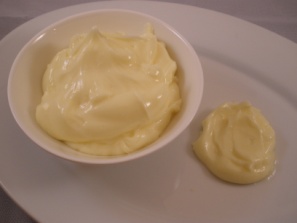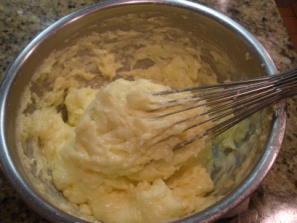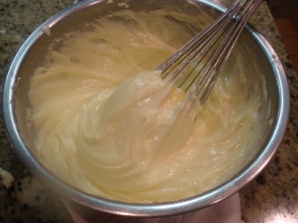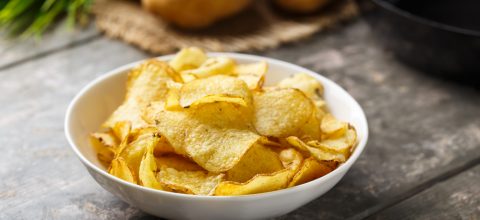If you are a fan of the old CBS show Northern Exposure, you may remember the episode when the doctor, Joel Fleischman, makes a trip back to Michigan with bush pilot Maggie O’Connell, with whom he has a love-hate relationship throughout the show, to catch a Knicks game. There was one scene where Joel, a Jewish man himself, was astonished by the buffet at Maggie’s parents’ house and poses the question, “What’s with Catholics and all the mayonnaise?” This is one of the more memorable food lines from film and television that has stuck with me, and it has been a bit of an inside joke of mine for many years. In the last few weeks I had a similar experience. In traveling to Chile, it was very apparent that it is not just us North Americans who have a love affair with the red-headed step-child of the classical mother sauces. It was everywhere, and in copious amounts. Not in fine dining necessarily, but at markets, street stalls, snack bars and quick service restaurants (commonly known as “QSR” in the culinary world).
 Mayonnaise, a once handmade commodity of the classical kitchen, has become a store shelf staple of the globe. In my neck of the woods, which boasts a substantial ethnic diversity, my local grocery stores are full of offerings from around the world. Is there any difference between them, from flavor, texture and taste? Is it a reminder of home that gives my neighbors a little security, and a way of passing down their childhood memories to their children who are now naturalized citizens? I will be doing a taste comparison on my blog in the next few days, so stay tuned.
Mayonnaise, a once handmade commodity of the classical kitchen, has become a store shelf staple of the globe. In my neck of the woods, which boasts a substantial ethnic diversity, my local grocery stores are full of offerings from around the world. Is there any difference between them, from flavor, texture and taste? Is it a reminder of home that gives my neighbors a little security, and a way of passing down their childhood memories to their children who are now naturalized citizens? I will be doing a taste comparison on my blog in the next few days, so stay tuned.
Getting back to my latest experience with the creamy white stuff… I describe it. that way for a reason, as this emulsion of egg yolks, oil, vinegar, salt and water is not for everyone. Some say it is taboo, either for health reasons or just wanting to live a certain way. For some it is just the look and feel of it on the palate that turns them off, and they just hate the stuff. I, on the other hand, love and appreciate it. Everyone starting out on his or her own is on a limited budget. Food was important to me, even back then, but I had to eat what I could afford. So, believe it or not, mayonnaise and fresh cracked black pepper on white bread was many a meal. It had all the components I needed in a meal (richness and body from the fats, pungency and a little texture of the pepper, acidity from the vinegar) and the bread just pulled it all together. In thinking about it, I am always looking for that moisture component in a sandwich, that element that comes from the richness and touch of acidity of mayonnaise or a similar spread.
 On this Chile trip, I was product testing hot dogs and sandwiches for a sales demo that I was doing, and there it was… the “Completo.” I had just read about in the latest issue of Lucky Peach (see below). This is a 10 to 1 hot dog, steamed and garnished with chopped tomatoes, mashed avocado and a thick ribbon of mayonnaise. The same was true of the “Lomito” sandwich: thinly-sliced beef churassco (roasted pork) topped with vegetables and plenty of mayonnaise. As if that was not enough, there were more condiments on the side: ketchup and even more mayonnaise. Even for me, a condiment lover, it was getting a little too much.
On this Chile trip, I was product testing hot dogs and sandwiches for a sales demo that I was doing, and there it was… the “Completo.” I had just read about in the latest issue of Lucky Peach (see below). This is a 10 to 1 hot dog, steamed and garnished with chopped tomatoes, mashed avocado and a thick ribbon of mayonnaise. The same was true of the “Lomito” sandwich: thinly-sliced beef churassco (roasted pork) topped with vegetables and plenty of mayonnaise. As if that was not enough, there were more condiments on the side: ketchup and even more mayonnaise. Even for me, a condiment lover, it was getting a little too much.
The Completo and Lomito were both pretty generic versions of menu offerings, though I would consider serving a form of both on a menu at some point. I would need to clean them up and make them a little more sophisticated for my tastes before that, though. I did a little more research and thought about other places around the world where mayo-topped street foods exist. Kewpie Japanese (see below) mayonnaise seasoned with sweet chili sauce on a kimchee quesadilla in LA, roasted corn bathed in mayo, chili, lime and cojita cheese in Mexico, and pomme frites and mayo in Belgium are just a few.
 In our culture, we have somewhat taken mayonnaise for granted. It is a pretty common item on the shelves of commercial and noncommercial kitchens alike and ubiquitous to flour… you just need to have it. There are some readers of this newsletter who may disagree with the rest of this, as they likely help sell a lot of it, but have we forgotten what real mayonnaise tastes like. We are accustomed to the heavy duty commercial product, and I do think there is a difference and opportunity for the “real” mayonnaise to get back on top. Hell, look at bacon and all the issues that go with it. Try taking that off a menu. Simple things, such as house made mayonnaise, can become a star of your menu construction…not just something you plop in a bowl and quickly mix with something.
In our culture, we have somewhat taken mayonnaise for granted. It is a pretty common item on the shelves of commercial and noncommercial kitchens alike and ubiquitous to flour… you just need to have it. There are some readers of this newsletter who may disagree with the rest of this, as they likely help sell a lot of it, but have we forgotten what real mayonnaise tastes like. We are accustomed to the heavy duty commercial product, and I do think there is a difference and opportunity for the “real” mayonnaise to get back on top. Hell, look at bacon and all the issues that go with it. Try taking that off a menu. Simple things, such as house made mayonnaise, can become a star of your menu construction…not just something you plop in a bowl and quickly mix with something.
Consider a Waldorf salad, and you’ll note that one of the key components is a heavy mayonnaise that coats the apples, celery and walnuts. The moisture from the vegetables and added lemon juice should not water down the mixture into a wet mess. The components should be loose and easily separated with a fork. Mayonnaise is not a glue or filler, as is the case with most commercially-produced mayonnaise-based salads. The task of making mayonnaise by hand is more than that, and should be.
Making mayonnaise by hand is also a story of legend of culinary school students the world over. These former students tell stories of having to make large bowls with a small whisk, their shoulders and forearms aching from whisking in the oil in a slow and steady stream. Yes, it is hard work, but it is worth it. Plus, it’s fun for the instructors seeing the students work for that perfect end product. Hand-whisked makes the best mayonnaise, but food processors or vertical cutting machines (VCMs) can work their magic, too.
 There are many recipes for making mayonnaise. In combing through Le Guide Culinaire for many years, I always passed over this recipe, #202. In preparing for the classical portion of the CMC®, I started documenting the process of making all of the elementary components from stocks, compound butters, cold sauces and, of course, mayonnaises. This is the real deal and here is how it’s done.
There are many recipes for making mayonnaise. In combing through Le Guide Culinaire for many years, I always passed over this recipe, #202. In preparing for the classical portion of the CMC®, I started documenting the process of making all of the elementary components from stocks, compound butters, cold sauces and, of course, mayonnaises. This is the real deal and here is how it’s done.
Ingredients:
- 6 fresh room temperature egg yolks
- 4½ cups neutral flavored oil (such as canola oil, salad oil, or vegetable oil)
- 1/3 oz salt
- Pinch of white pepper
- 1½ tbsp of lemon juice. If you are not worried about your product having a white color, use vinegar.
Ingredients:
- Whisk together the egg yolks, salt, pepper and few drops of the lemon juice.
- Set the bowl on a damp towel so it doesn’t move while you’re mixing.
- At the beginning, add the oil drop by drop and whisk thoroughly as the oil is incorporated.
- Slowly increase the speed of the pouring oil (from drop by drop to a thin ribbon) and continue whisking so the oil is incorporated completely. The more oil added, the harder and thicker the mayonnaise will be.
- When all of the oil is incorporated, add the lemon juice. At this point the mayonnaise may look lumpy and broken, and that’s okay.
- Whisk in 2 tbsp of the boiling water-this will bring the whole thing together.
 House made mayonnaise is best prepared daily, but it can be made in bulk. Long before the health department started knocking on the doors and labeling things as PHFs (potentially hazardous foods), mayonnaise was simply covered and stored at room temperature. Whether you decide to store it in this traditional way or in your fridge is your call. When made like this, using simple, quality ingredients, the difference is noticeable. There is no sugar, no sweeteners. It is a mayonnaise that is plain and perfect. If you are spending quality dollars on artisan hams and good tuna, why not put that same effort and care into making the mayonnaise from scratch?
House made mayonnaise is best prepared daily, but it can be made in bulk. Long before the health department started knocking on the doors and labeling things as PHFs (potentially hazardous foods), mayonnaise was simply covered and stored at room temperature. Whether you decide to store it in this traditional way or in your fridge is your call. When made like this, using simple, quality ingredients, the difference is noticeable. There is no sugar, no sweeteners. It is a mayonnaise that is plain and perfect. If you are spending quality dollars on artisan hams and good tuna, why not put that same effort and care into making the mayonnaise from scratch?
Enjoy!

Good Read
Lucky Peach Issue 10: The Street Food Issue

Read the stories “Sausage Party” and the “Completo”. Click here to check out the book.
Mayo From Across The Globe

Here is a favorite of a lot of Asian Kitchens and fast food joints. Creamy and slightly sweet.










